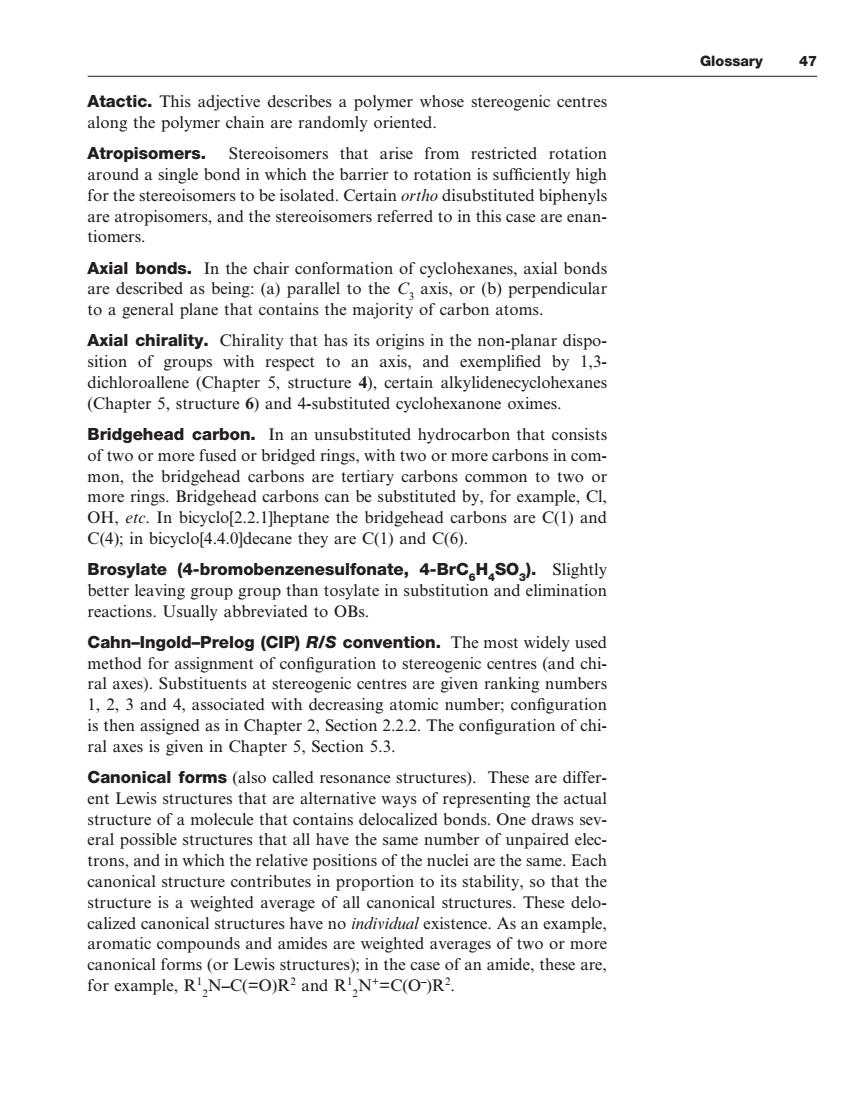正在加载图片...

Glossary 47 Atactic.This adjective describes a polymer whose stereogenic centres along the polymer chain are randomly oriented. Atronisomers Stereoisomers that arise from restricted rotation around a single bond in which the barrier to rotation is sufficiently high are atropisomers,and the stereoisomers referred to in this case are enan- tiomers. Axial bonds.In the chair conformation of cyclohexanes,axial bonds are described as being:(a)parallel to the C axis,or(b)perpendicular to a general plane that contains the majority of carbon atom Axial chirality.Chirality that has its origins in the non-planar dispo- sition of groups with respect to an axis,and exemplified by 1,3- dichloroallene (Chapter 5,structure 4),certain alkylidenecyclohexanes (Chapter 5,structure 6)and 4-substituted cyclohexanone oximes Bridgehead carbon.In an unsubstituted hydrocarbon that consists of two or more fused or bridged rings,with two or more carbons in com- mon.the bridgehead carbons are tertiary carbons common to two or more rings.Bridgehead carbons can be substituted by,for example.Cl. OH,etc.In bicy .2.1]hept ane the bridgehead ca bons are C(1)and C(4);in bicyclo[4..0decane they are C(1)and C(6) Brosylate (4-bromobenzenesulfonate,4-BrC H SO,).Slightly better leaving groupgroup than tosylate in substitution and elimination reactions.Usually abbreviated to OBs. Cahn-Ingold-Prelog(CIP)R/S convention.The most widely used method for assignment of configuration to stereogenic centres (and chi- ral axes).Substituents at stereogenic centres are given ranking numbers 1,2,3 and 4,associated with decreasing atomic number;configuration is then assigned as in Chapter 2,Section 2.2.2.The configuration of chi ral axes is given in Chapter 5,Section 5.3 Canonical forms(also called resonance structures).These are differ- ent Lewis structures that are alternative ways of representing the actual structure of a molecule that contains delocalized bonds One draws sev eral possible structures that all have the same number of u npaired elec. trons,and in which the relative positions of the nuclei are the same.Each canonical structure contributes in proportion to its stability,so that the structure is a weighted average of all canonical structures.These delo- calized canonical structures have no individual existence.As an example, aromatic compounds and amides are weighted averages of two or m canonical fo or Lewis structure n the case of an amide,these are. for example,RN-C(=O)R2 and R,N+=C(O-)R2 Atactic. This adjective describes a polymer whose stereogenic centres along the polymer chain are randomly oriented. Atropisomers. Stereoisomers that arise from restricted rotation around a single bond in which the barrier to rotation is sufficiently high for the stereoisomers to be isolated. Certain ortho disubstituted biphenyls are atropisomers, and the stereoisomers referred to in this case are enantiomers. Axial bonds. In the chair conformation of cyclohexanes, axial bonds are described as being: (a) parallel to the C3 axis, or (b) perpendicular to a general plane that contains the majority of carbon atoms. Axial chirality. Chirality that has its origins in the non-planar disposition of groups with respect to an axis, and exemplified by 1,3- dichloroallene (Chapter 5, structure 4), certain alkylidenecyclohexanes (Chapter 5, structure 6) and 4-substituted cyclohexanone oximes. Bridgehead carbon. In an unsubstituted hydrocarbon that consists of two or more fused or bridged rings, with two or more carbons in common, the bridgehead carbons are tertiary carbons common to two or more rings. Bridgehead carbons can be substituted by, for example, Cl, OH, etc. In bicyclo[2.2.1]heptane the bridgehead carbons are C(1) and C(4); in bicyclo[4.4.0]decane they are C(1) and C(6). Brosylate (4-bromobenzenesulfonate, 4-BrC6H4SO3). Slightly better leaving group group than tosylate in substitution and elimination reactions. Usually abbreviated to OBs. Cahn–Ingold–Prelog (CIP) R/S convention. The most widely used method for assignment of configuration to stereogenic centres (and chiral axes). Substituents at stereogenic centres are given ranking numbers 1, 2, 3 and 4, associated with decreasing atomic number; configuration is then assigned as in Chapter 2, Section 2.2.2. The configuration of chiral axes is given in Chapter 5, Section 5.3. Canonical forms (also called resonance structures). These are different Lewis structures that are alternative ways of representing the actual structure of a molecule that contains delocalized bonds. One draws several possible structures that all have the same number of unpaired electrons, and in which the relative positions of the nuclei are the same. Each canonical structure contributes in proportion to its stability, so that the structure is a weighted average of all canonical structures. These delocalized canonical structures have no individual existence. As an example, aromatic compounds and amides are weighted averages of two or more canonical forms (or Lewis structures); in the case of an amide, these are, for example, R1 2 N–C(=O)R2 and R1 2 N+=C(O– )R2 . Glossary 47